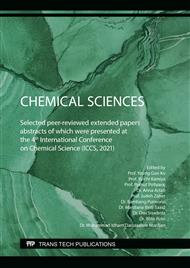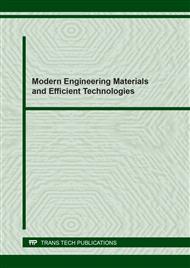[1]
IEA, World Energy Outlook, International Energy Agency, Paris, France, (2018).
Google Scholar
[2]
D. Alfarge, M. Wei, B. Bai, A parametric study on the applicability of miscible gases based EOR techniques in unconventional liquids-rich reservoirs, SPE Canada Unconventional Resources Conference, Society of Petroleum Engineers, Calgary, Alberta, Canada, 2018, p.1–23.
DOI: 10.2118/189785-ms
Google Scholar
[3]
D. Afekare, J. Garno, D. Rao, Enhancing oil recovery using silica nanoparticles: Nanoscale wettability alteration effects and implications for shale oil recovery, J. Pet. Sci. Eng. 203 (2021) 108897.
DOI: 10.1016/j.petrol.2021.108897
Google Scholar
[4]
I. Khan, K. Saeed, I. Khan, Nanoparticles: Properties, applications and toxicities, Arabian J. Chem. 12 (2017) 908–931.
DOI: 10.1016/j.arabjc.2017.05.011
Google Scholar
[5]
A.I. El-Diasty, A.M.S. Ragab, Applications of nanotechnology in the oil & gas industry: latest trends worldwide & future challenges in Egypt, Society of Petroleum Engineers-North Africa Technical Conference and Exhibition 2013 (NATC 2013), Cairo, 2013, p.1036–1048.
DOI: 10.2118/164716-ms
Google Scholar
[6]
I.N. Evdokimov, N.Y. Eliseev, A.P. Losev, M.A. Novikov, Emerging petroleum-oriented nanotechnologies for reservoir engineering, SPE Russian Oil and Gas Technical Conference and Exhibition 2006: Technology for world-class resources, vol. 1. Curran Associates, Incorporated, West Chester, 2007, p.370–378.
DOI: 10.2118/102060-ru
Google Scholar
[7]
N.A. Ogolo, O.A. Olafuyi, M.O. Onyekonwu, Enhanced oil recovery using nanoparticles, in: SPE Saudi Arabia Section Technical Symposium and Exhibition, Society of Petroleum Engineers, Al-Khobar, 2012, p.1–9.
DOI: 10.2118/160847-ms
Google Scholar
[8]
H. Zhang, T.S. Ramakrishnan, A. Nikolov, D. Wasan, Enhanced oil recovery driven by nanofilm structural disjoining pressure: Flooding experiments and microvisualization, Energy Fuels 30 (2016), 2771–2779.
DOI: 10.1021/acs.energyfuels.6b00035
Google Scholar
[9]
O.A. Alomair, K.M. Matar, Y.H. Alsaeed, Nanofluids application for heavy oil recovery, Proceedings of the SPE Asia Pacific Oil and Gas Conference and Exhibition – Changing the Game: Opportunities, Challenges and Solutions, APOGCE2014, 2014, p.1346–1363.
DOI: 10.2118/171539-ms
Google Scholar
[10]
T. Lu, Z. Li, Y. Zhou, C. Zhang, Enhanced oil recovery of low-permeability cores by SiO2 nanofluid, Energy Fuels 31 (2017) 5612–5621.
DOI: 10.1021/acs.energyfuels.7b00144
Google Scholar
[11]
M.P. Alvarez-Berrios, L.M. Aponte-Reyes, L.M. Aponte-Cruz, P. Loman-Cortes, J.L. Vivero-Escoto, Effect of the surface charge of silica nanoparticles on oil recovery: Wettability alteration of sandstone cores and imbibition experiments, Int. Nano Lett. 8 (2018) 181–188.
DOI: 10.1007/s40089-018-0243-5
Google Scholar
[12]
S. Purbo, Sintesis dan Karakterisasi Nanopartikel Nanofluida Undoped ZnO (Seng Oksida) dengan Metode Kopresipitasi dan Aplikasinya pada Heat Pipe, Undergraduate Thesis, Universitas Indonesia, Jakarta, (2012).
DOI: 10.31258/jkfi.19.2.91-98
Google Scholar
[13]
Y.I. Hidayat, Sintesis dan Karakterisasi Zeolit Alam Tersuport Nanopartikel TiO2 sebagai Katalis Heterogen untuk Produksi Biodiesel dari Minyak Kelapa Sawit, Undergraduate Thesis, Universitas Negeri Yogyakarta, Yogyakarta, (2020).
DOI: 10.23960/aec.v6.i1.2021.p92-100
Google Scholar
[14]
S. Silviana, A. Darmawan, F. Dalanta, A. Subagio, F. Hermawan, H.M. Santoso, Superhydrophobic coating derived from geothermal silica to enhance material durability of bamboo using hexadimethylsilazane (HMDS) and trimethylchlorosilane, Materials 14 (2021) 530.
DOI: 10.3390/ma14030530
Google Scholar
[15]
Y. Kusumastuti, H.T.B.M. Petrus, F. Yohana, A.T. Buwono, R.B. Zaqina, Synthesis and characterization of biocomposites based on chitosan and geothermal silica, AIP Conf. Proc. 1823 (2017), 020127.
DOI: 10.1063/1.4978200
Google Scholar
[16]
S.N.A. Jenie, A. Ghaisani, Y.P. Ningrum, A. Kristiani, F. Aulia, HTMB Petrus, Preparation of silica nanoparticles from geothermal sludge via sol-gel method, AIP Conf. Proc. 2026 (2018), 020008.
DOI: 10.1063/1.5064968
Google Scholar
[17]
A. Arnelli, Y. Astuti, Kimia Koloid dan Permukaan, Deepublish, Yogyakarta, (2019).
Google Scholar
[18]
T. Jesionowski, Characterization of silicas precipitated from solution of sodium metasilicate and hydrochloric acid in emulsion medium, Powder Technol. 127 (2002) 56–65.
DOI: 10.1016/s0032-5910(02)00093-1
Google Scholar
[19]
S. Azarshin, J. Moghadasi, Z.A. Aboosadi, Surface functionalization of silica nanoparticles to improve the performance of water flooding in oil-wet reservoirs, Energy Explor. Exploit. 35 (2017) 685–697.
DOI: 10.1177/0144598717716281
Google Scholar
[20]
A. Maghzi, S. Mohammadi, M.H. Ghazanfari, R. Kharrat, M. Masihi, Monitoring wettability alteration by silica nanoparticles during water flooding to heavy oils in five-spot systems: A pore-level investigation, Exp. Therm. Fluid Sci. 40 (2012) 168–176.
DOI: 10.1016/j.expthermflusci.2012.03.004
Google Scholar
[21]
E. Joonaki, S. Ghanaatian, The application of nanofluids for enhanced oil recovery: Effects on interfacial tension and coreflooding process, Pet. Sci. Technol. 32 (2014) 2599–2607.
DOI: 10.1080/10916466.2013.855228
Google Scholar



